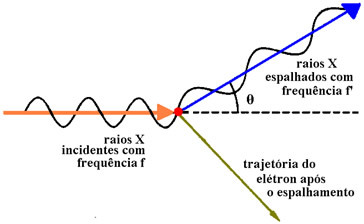It was in the year 1922 that Arthur Holly Compton, after conducting some studies on interaction radiation-matter, realized that when an X-ray beam hit a carbon target, it suffered a spreading. Initially, Compton didn't notice anything amiss, as his measurements indicated that the scattered beam had a different frequency than the incident beam just after it passed through the target.
According to the wave theory, this concept was taken for granted, as the frequency of a wave is not altered by any phenomenon that occurs with it, being characteristic of the source that produces it. But what was found, through experimentation, was that the frequency of the scattered X-rays was always lower than the frequency of the incident X-rays, depending on the angle of deviation. The figure below shows us the scheme of the occurrence of this phenomenon, known as Compton Effect.

To explain what happened, Compton was inspired by Einstein's approach, that is, he interpreted the X-rays as being beams of particles and the interaction as a collision of particles. The energy of the incident photon, according to Einstein and Planck, would be h.f; and the scattered photon would have an electron, in respect of the law of energy conservation.
The approach worked perfectly, but Compton went even further. He also investigated the interaction from the point of view of the law of conservation of linear momentum. Experimentally, he verified that this law was valid for several scattering angles, as long as the linear moment of the photon was defined as

Where:
- ç – is the speed of light in a vacuum
- H – is Planck's constant
- λ – is the wavelength of the radiation
The inventor of the Cloud Chamber (Charles Wilson) experimentally obtained the trajectories of photons and scattered electrons, in collaboration with Compton. Two features are notable in the above expression: one is the redefinition of linear momentum itself, which cannot be written as mv, because the photon has no mass; and the other characteristic that can be observed is the establishment of a clear association between a typical quantity of corpuscles, that is, matter, and a characteristically undulatory quantity.
Compton further developed a method that proved that the photon and electron were scattered simultaneously, which precluded explanations involving absorption and subsequent emission of radiation.
By Domitiano Marques
Graduated in Physics
